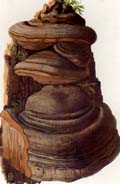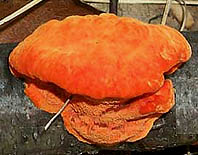Abortiporus biennis
 Key to Gilled Mushrooms Key
Key to Gilled Mushrooms KeyThis is a key to gilled mushrooms, that is, mushrooms having a definite cap with a fertile surface consisting of gills. The fruiting body usually also has a stem, although that may be lateral or absent (usually, then, the mushroom is growing from wood). You can use this key to identify mushrooms that you find.
 Polyporaceae Family
Polyporaceae FamilyFertile surface usually a layer of vertical tubes, of which the mouths are visible as pores on the underside of the cap or shelf.
Fruiting bodies usually tougher or harder than the "normal" gilled mushrooms, being leathery, corky, or woody. But they can be quite tender while actively growing
Once grown, they do not decay easily, remaining on the substrate for months or years
They often grow on wood, although a few are terrestrial (even those are usually growing on buried wood)
Fruiting body is usually a flat shelf, or hoof-shaped, protruding directly from the substrate, although sometimes it may have a short stalk.
Some forms never grow away from the substrate at all, so that all that is visible of the fruiting body are the pores.
Sometimes the pores are so minute that the fertile surface seems solid, until you look closely
 Lignicopolypore Subfamily
Lignicopolypore SubfamilyGrowing on wood
 Red Polypore Tribe
Red Polypore TribeThe pores red, pink, or orange-red, or the cap at least partially one of those colors
 Red Cap Polypore Subtribe
Red Cap Polypore SubtribeCap at least partly red, pink or red-orange
Pore surface white to pale buff, but may discolor reddish
 Abortiporus Genus
Abortiporus Genus
Here are the characters that distinguish this species from the others in its group. For its more general characters, see higher up on the page.
If there's just a few words or a microscopic feature here, a more thorough description can be found above.

Diagnosis
- Frequently contorted, twisted, etc, and thus totally variable in shape; in particular, it can have pores on just about any part of the fruiting body
-
Cap up to 9" across; greyish cream to pinkish tan, sometimes reddening when handled; usually hairy
-
Stalk usually tapering from a wide base upward;
-
As with many polypores, it can develop in a rosette from a stalk when growing straight up from its substrate, or in a sessile shelf when growing out sideways; it also grows in a capless form which basically looks like a finger covered with pores, and one shaped like a shoehorn.

- Other important features: the pores-walls break up in age, so the hymenophore becomes daedaloid rather than poroid
-
My collections have also been more velvety/felty, especially on the cap, than the rather coarse hairs in the picture; and they've also been much greyer. I have quite a few unscanned photos of it. Hopefully they will be up soon.
- Arora (1986) says that it discolors pink or reddish in age or when handled; R. L. Gilbertson & Ryvarden (1986 - 1987) say "often with a pinkish tone when fresh." Which of them is correct? Find out and earn yourself a degree
Comments
This is one of the many fungi that we find all the time in the Chicago area, but which has always seemed too common, non-descript, or even downright ugly to bother photographing. As a result, we have to make due with this image from 1817, and I'm not sure that there's a published color one since then. Lee Oras Overholts & J. L. Lowe's (1953) Polyporaceae of the United States, Alaska, and Canada has a few black-and-white photos, but they are not a big improvement over the advice that this species is more often recognized by its contortions than by any other feature. Arora (1986) has a description but no picture; the other major field guides snub it entirely
You'll just have to tune in here for the latest information!
Due to its extremely variable appearance, this fungus has been placed in many different genera, and has been described as new several times by mycologists who were unable to place it. So don't feel bad if you also find it difficult to identify. Actually, although I've read many comments about its variability, I feel that this feature has been exaggerated. I have found it only in the fairly recognizable forms of rosette, shoehorn and finger mentioned in the diagnosis. It occurred several times in the shoehorn form at the 2001 NAMA foray in Minnesota, eluding identification by all the mycologists there.
Perhaps my experience with Abortiporus morphology has been because I have only found it on the roots of oak trees. Its other major habitat is on coniferous wood (regretably absent around Chicago) - - presumably that's where it does its "shelving" thing (it's hard to be shelving when you're coming up from oak roots), and maybe that's also the venue for the more contorted forms. No bets on whether the conifer form will eventually be split from the oak-root one...






 Key to Gilled Mushrooms Key
Key to Gilled Mushrooms Key Polyporaceae Family
Polyporaceae Family Red Polypore Tribe
Red Polypore Tribe Red Cap Polypore Subtribe
Red Cap Polypore Subtribe Abortiporus Genus
Abortiporus Genus






